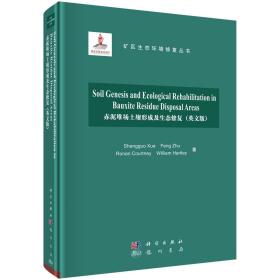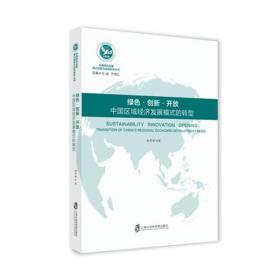
赤泥堆场土壤形成及生态修复(英文版)
正版品相完好,套书和多封面版本咨询客服后再下单
¥ 163.78 6.6折 ¥ 249 九品
仅1件
北京东城
认证卖家担保交易快速发货售后保障
作者薛生国 著
出版社科学出版社
出版时间2020-10
版次1
装帧其他
上书时间2024-05-26
- 最新上架
商品详情
- 品相描述:九品
图书标准信息
- 作者 薛生国 著
- 出版社 科学出版社
- 出版时间 2020-10
- 版次 1
- ISBN 9787508857800
- 定价 249.00元
- 装帧 其他
- 开本 16开
- 纸张 胶版纸
- 页数 302页
- 【内容简介】
- Ecological rehabilitation is the most effective sÊËategy to remediate bauxite residue on a large scale. To improve this process, soil genesis is considered a key process to support plant establishment. This book systematically introduces the latest research on bauxite residue characteristics, soil genesis, saline-alkali regulation, aggregate formation, environmental risk, including several case studies of ecological rehabilitation on bauxite residue disposal areas. This book will provide scientific reference for the alumina industry and researchers working on the restoration of large-scale bauxite disposal areas and enhance theoretical research on the disposal of1arge industrial solid waste wor1dwide.
- 【目录】
-
Contents
Chapter 1 Characterization and Disposal of Bauxite Residue 1
1.1 Introduction 1
1.2 Generation of Bauxite Residue 3
1.2.1 Bauxite Production and Global Reserves 3
1.2.2 Production Process of Alumina 4
1.2.3 Annual Production and Inventory of Bauxite Residue 6
1.3 Properties of Bauxite Residue 6
1.3.1 Physical Properties 6
1.3.2 Chemical Properties 7
1.3.3 Biological Properties 13
1.4 Management of Bauxite Residue 14
1.4.1 Conventional Disposal of Bauxite Residue 14
1.4.2 Utilization of Bauxite Residue 14
1.5 Alkalinity Transformation of Bauxite Residue 15
1.5.1 Alkaline Solid Transformation 15
1.5.2 Waste Acid Synergy 20
1.5.3 Acid Gas Sequestration 21
1.5.4 Chloride Salt Neutralization 24
1.6 Soil Formation and Revegetation of Bauxite Residue 26
1.6.1 Amelioration of Bauxite Residue 27
1.6.2 Screening of Tolerant Plant Species and Microorganisms 28
1.6.3 Soil Formation in Bauxite Residue 30
References 31
Chapter 2 Novel Predictors of Soil Genesis in Bauxite Residue under Natural Weathering Processes 38
2.1 Natural Evolution of Alkaline Characteristics in Bauxite Residue 38
2.1.1 Transformation of Basic Alkalinity 40
2.1.2 Transformation of Electrical Conductivity 42
2.1.3 Transformation of Exchangeable Cations 43
2.1.4 Transformation of Acid Neutralizing Capacity 45
2.1.5 Environmental Management for Long-Term Disposal 47
2.2 Natural Plant Colonization Improves Physical Conditions of Bauxite Residue 47
2.2.1 Particle Size Distribution 48
2.2.2 Bulk Density and Total Porosity 50
2.2.3 Mean Weight Diameter (MWD) and Water-Stable Aggregates (WSA) 51
2.2.4 Structural Stability Index (SI) 52
2.3 Development of Alkaline Electrochemical Characteristics 52
2.3.1 Mineralogy 53
2.3.2 Zeta Potential Curves and Isoelectric Point 56
2.3.3 Surface Protonation and Alkaline Group 58
2.4 Dynamic Development of Bacterial Community Diversity and Structure 60
2.4.1 Residue Properties 61
2.4.2 Diversity of Bacterial Community 62
2.4.3 Composition of Bacterial Community 63
2.4.4 Correlation between Bacterial Community and Residue Property 67
2.5 Novel Predictors of Soil Genesis in Bauxite Residue 69
2.5.1 Variation of Chemical Properties 70
2.5.2 Variation of Physical Properties 72
2.5.3 Effects on Aggregate Stability 73
2.5.4 Novel Predictors of Soil Genesis 76
References 78
Chapter 3 Aggregate Formation and Stability in Bauxite Residue Following Soil Genesis 87
3.1 Erosion Resistance of Water-Stable Aggregates in Bauxite Residue 87
3.1.1 Distribution of Aggregate Fractions and MWD by the Modified Yoder¡¯s Method 87
3.1.2 Distribution of Aggregate Fractions and MWD by the Modified Le Bissonnais£¬Method 89
3.1.3 The Erodibility Factor (K) of Bauxite Residues 91
3.1.4 Variable Effectiveness of Mechanisms to Erosion of Bauxite Residue 93
3.2 Effects of Iron-Aluminum Oxides and Organic Carbon on Aggregate Stability 95
3.2.1 Iron-Aluminiim Oxide Contents and Their Relationship with Aggregate Stability 95
3.2.2 Aggregate-Associated Carbon and the Relationship with Aggregate Stability 97
3.2.3 Variation of Aggregate-Associated Organic Carbon Functional Groups 99
3.3 Fractal Features of Residue Microaggregates in Bauxite Residue Disposal Areas 101
3.3.1 Particle Size Distribution of Residue Microaggregates 102
3.3.2 Microaggregate Stability of the Residues 105
3.3.3 Single-Fractal Features of Residue Microaggregates 109
3.3.4 Multi-Fractal Dimension of Residue Microaggregates Ill
3.3.5 Relationship between Microaggregate Stability and Fractal Parameters 114
3.4 Effects of Binding Materials on Micro-Aggregate Size Distribution in Bauxite Residues 115
3.4.1 Effect of Organic Matter 115
3.4.2 Effect of Carbonate on Residue Microaggregate Size Distribution 117
3.4.3 Effect of Electrolyte on Residue Microaggregate Size Distribution 118
3.4.4 Effect of Clay Mineralogy on Residue Microaggregate Size Distribution 120
3.4.5 Effect of Iron-Aluminum Oxides on Residue Microaggregate Size Distribution 121
3.5 Evaluation on Aggregate Microstructures Following Natural Regeneration 122
3.5.1 Residue Micromorphology 122
3.5.2 Visualization of Soil Aggregates 126
3.5.3 Porosity and Pore-Size Distribution 127
3.5.4 Shape Parameters in Residue Aggregates 128
3.5.5 Effects on Residue Aggregate Microstructure 130
3.6 Vermicompost and Gypsum Improve Aggregate Formation in Bauxite Residue 131
3.6.1 Residue Properties 132
3.6.2 Residue Macroaggregate Formation 134
3.6.3 Residue Microaggregate Formation 137
3.6.4 Residue Micromorphology 139
References 141
Chapter 4 Regulation on Saltinity and Alkalinity of Bauxite Residue Following Soil Genesis 149
4.1 Migration and Distribution of Saline Ions in Bauxite Residue during Water Leaching 149
4.1.1 Change of Saline Cation Concentration in Leachate 150<
点击展开
点击收起
— 没有更多了 —












以下为对购买帮助不大的评价